
Nash Motors Company was an American automobile manufacturer based in Kenosha, Wisconsin from 1916 until 1937. From 1937 through 1954, Nash Motors was the automotive division of the Nash-Kelvinator Corporation. As sales of smaller firms declined after 1950 in the wake of the domestic Big Three automakers’ advantages in production, distribution, and revenue, Nash merged with Hudson Motors to form American Motors Corporation (AMC). Nash automobile production continued from 1954 through 1957 under AMC.

Kaiser Motors Corporation made automobiles at Willow Run, Michigan, United States, from 1945 until 1953. In 1953, Kaiser merged with Willys-Overland to form Willys Motors Incorporated, moving its production operations to the Willys plant at Toledo, Ohio, where the company continued to build automobiles under the Kaiser marque including the Kaiser Darrin until 1955. Their South American operations continued to build passenger cars well up into the 1960s. The company changed its name to Kaiser Jeep Corporation in 1963.

Maurice Bienvenu Jean Paul Trintignant was a motor racing driver and vintner from France. He competed in the Formula One World Championship for fourteen years, between 1950 and 1964, one of the longest careers in the early years of Formula One. During this time he also competed in sports car racing, including winning the 1954 24 Hours of Le Mans race. Following his retirement from the track Trintignant concentrated on the wine trade.
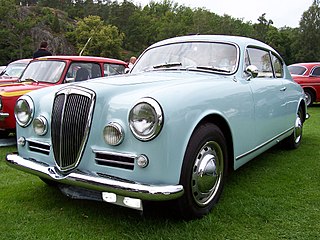
A grand tourer (GT) is a type of car that is designed for high speed and long-distance driving due to a combination of performance and luxury attributes. The most common format is a front-engine, rear-wheel-drive two-door coupé with either a two-seat or a 2+2 arrangement. Grand tourers are most often the coupé derivative of luxury saloons or sedans. Many iconic car models, such as the Ferrari 250 GT, Jaguar E-Type, and Aston Martin DB5, are considered classic examples of gran turismo cars.
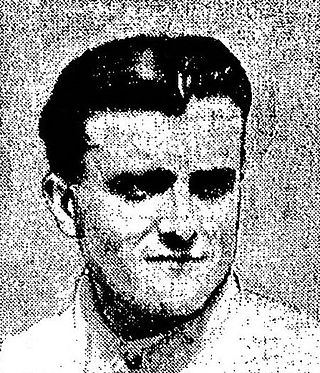
Luigi Chinetti was an Italian-born racecar driver, who emigrated to the United States during World War II. He drove in 12 consecutive 24 Hours of Le Mans races, taking three outright wins there and taking two more at the Spa 24 Hours race. Chinetti owned the North American Racing Team, which successfully ran privateer Ferraris in sports car and Formula One races. For many years he was the exclusive American importer of Ferrari automobiles to the United States.

Charles Joseph "Chuck" Stevenson was an American racing driver who competed in various disciplines of motorsport. He is best known for winning the AAA National Championship in 1952. Stevenson also had two class victories in the Carrera Panamericana and won a NASCAR Grand National event.

Frazer Nash was a brand of British sports car manufactured from 1922 first by Frazer Nash Limited founded by engineer Archibald Frazer-Nash. On its financial collapse in 1927 a new company, AFN Limited, was incorporated. Control of AFN passed to Harold John Aldington in 1929.

The Nash-Healey is a three-seat luxury sports car or grand tourer produced from 1951 to 1954. It was marketed by the Nash-Kelvinator conglomerate in North America as a halo car to promote sales of its Nash Motors division.
The Kaiser-Frazer Corporation was an American automobile company. It was founded jointly by industrialist Henry J. Kaiser and automobile executive Joseph W. Frazer. In 1947, the company acquired the automotive assets of Graham-Paige, of which Frazer had become president near the end of World War II. Kaiser-Frazer was one of a few US automakers to achieve success after World War II, if only for a few years. Joseph W. Frazer left the company in 1949, replaced as president by Henry's son Edgar F. Kaiser.

The Nash Ambassador is a luxury automobile that was produced by Nash Motors from 1927 until 1957. For the first five years it was a top trim level, then from 1932 on a standalone model. Ambassadors were lavishly equipped and beautifully constructed, earning them the nickname "the Kenosha Duesenberg".

The Henry J is an American automobile built by the Kaiser-Frazer Corporation and named after its chairman, Henry J. Kaiser. Production of six-cylinder models began in their Willow Run factory in Michigan in July 1950, and four-cylinder production started shortly after Labor Day, 1950. The official public introduction was on September 28, 1950, and the car was marketed through 1954.

The Hudson Hornet is a full-size car manufactured by Hudson Motor Car Company of Detroit, Michigan from 1951 until 1954, when Nash-Kelvinator and Hudson merged to form American Motors Corporation (AMC). Hudson automobiles continued to be marketed under the Hudson brand name through the 1957 model year.

Patrick Peter Mitchell-Thomson, 2nd Baron Selsdon won the 1949 24 Hours of Le Mans together with Luigi Chinetti in a Ferrari 166 MM.

The 1952 24 Hours of Le Mans was the 20th Grand Prix of Endurance, and took place on 14–15 June 1952 at Circuit de la Sarthe.

ASA Aluminium Body is an Argentinian company that produces exact replicas of racing cars from the 1930s, 1940s and 1950s. The company is headquartered in Don Torcuato, a city in Tigre Partido.

The BMW OHV V8 is an overhead valve V8 petrol engine produced from 1954 to 1965. It is BMW's first V8 engine, and BMW did not produce another V8 automobile engine until the BMW M60 in 1992.
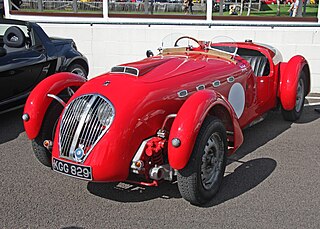
The Healey Silverstone is an open, two-seat sports car produced by the Donald Healey Motor Company beginning in 1949. It is named for the Silverstone Circuit racetrack, where it appeared on its second competition outing. The car has a narrow roadster style body and cycle wings. Designed as a dual purpose car for both road and track, the Silverstone became popular in club racing.
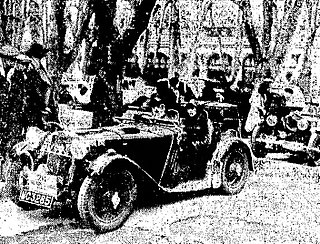
Elizabeth Haig (1905–1987) was a British racing driver who competed in rallying, hill climbs and historic racing. She won the 1936 Olympic Rally, the first and last time after 1900 that an automobile race was part of the Olympic Games.
The Sebring International Grand Prix of Endurance, was a non-championship race. The race was held at the Sebring International Raceway, on March 15, 1952. Victory overall went to the No. 9 J. S. Donaldson Frazer Nash Le Mans Replica driven by Larry Kulok and Harry Grey.
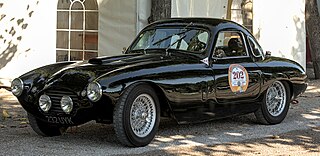
The Frazer Nash Le Mans Coupe, is a sports race car, designed, developed, and built by British manufacturer Frazer Nash, between 1953 and 1956.



















